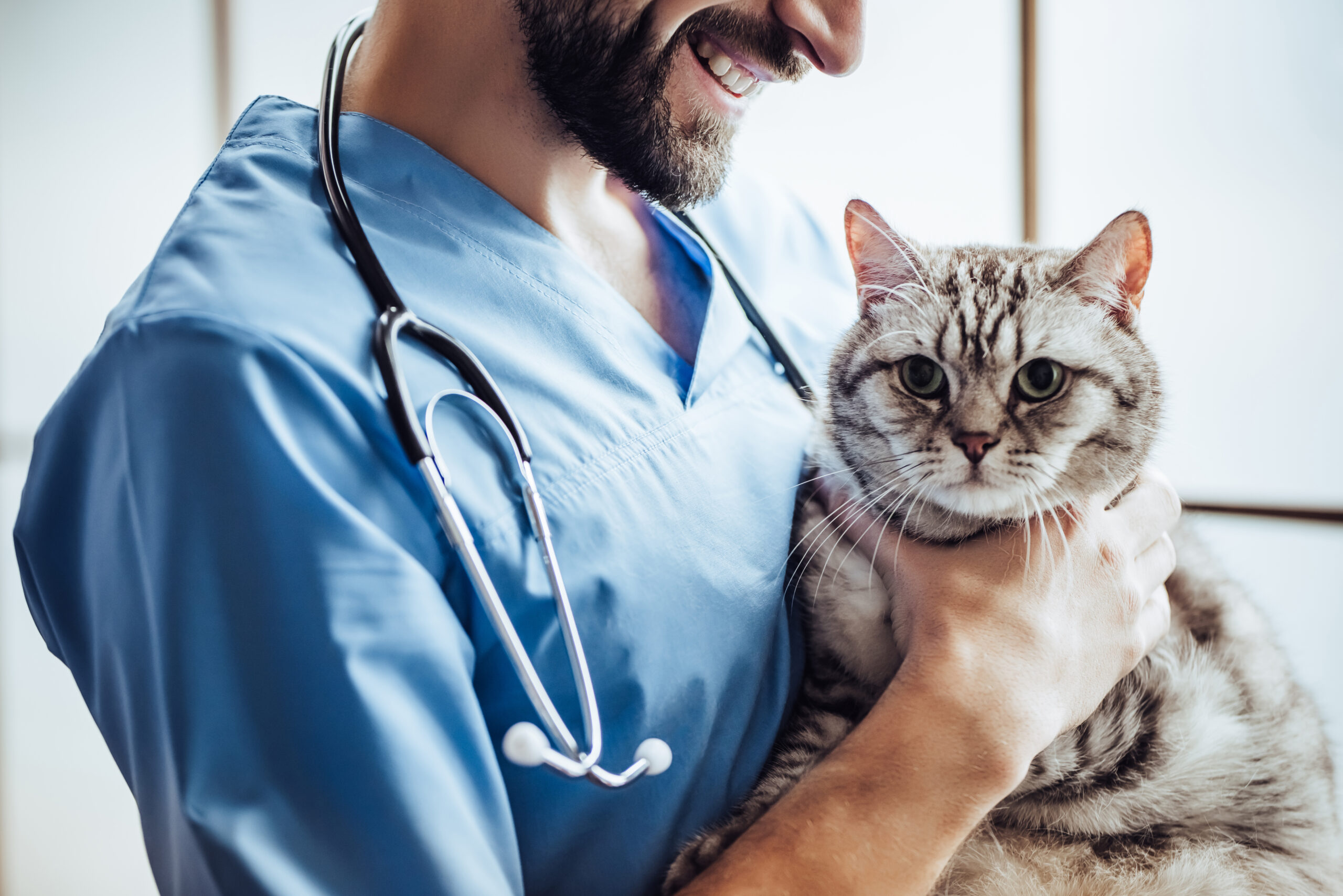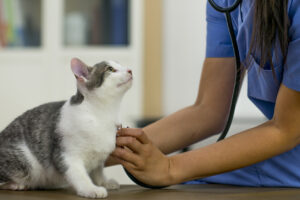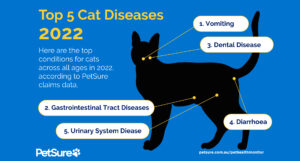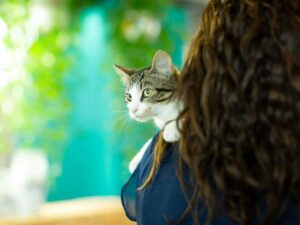What is Cat Flu?
Like any other pet, our cats can get sick too. One common illness affecting cats of all ages is “cat flu”. Not a “flu” at all, cat flu is also known as feline respiratory disease. It is a viral infection that affects the upper respiratory system of cats. It is a highly contagious illness that can be transmitted from one cat to another through direct contact or through sharing food and water bowls, litter boxes, and bedding.
The two most common viruses that cause cat flu are feline herpesvirus (FHV) and feline calicivirus (FCV). Other viruses that can cause cat flu include the feline coronavirus (FCoV) and bacteria Chlamydophila Felis and Bordetella Bronchiseptica.
Signs & Symptoms
The signs and symptoms of cat flu can vary depending on the severity of the infection and the causative viruses. Some common signs and symptoms include:
- Sneezing
- Runny nose
- Watery eyes
- Conjunctivitis
- Fever
- Loss of appetite
- Lethargy/decreased activity
- Dehydration
- Coughing
- Ulcers on the tongue and gums
Other symptoms include aches and pains in the muscles and joints, mouth ulcers, dribbling, sneezing, loss of voice and fever. With cat flu, ocular signs are common including conjunctivitis and eye ulcers and particularly in kittens, can progress to cause permanent damage to the eye. Kittens, elderly, or unwell cats are more likely to be severely affected by cat flu. If you suspect that your cat has cat flu, reach out to your veterinarian.
Diagnosis
Diagnosing cat flu includes a thorough physical examination of the cat by the veterinarian as well as questions about the symptoms and medical history. This can often include questions about recent boarding, vaccination status or where and when the pet was acquired, as well as any other pertinent information like changes in diet, or home routines. It is not uncommon for a diagnosis of cat flu to be made symptomatically, based on the cat’s observed clinical signs and history without further testing.
Further diagnostic tests such as a blood tests or a swab of your cat’s nose or throat to identify the specific virus or bacteria causing the infection may be recommended in more severe or ongoing cases, or when a specific diagnosis is required.
Treatment
There is no specific treatment for cat flu, so typically the treatment is symptomatic depending on what the feline patient is experiencing. In most cases, supportive care and medications are used to manage the symptoms and help the cat recover.
Some common treatments for cat flu include:
• Antibiotics: If the cat has a bacterial infection, antibiotics may be prescribed to help fight the infection. It’s important to remember that antibiotics don’t treat viral infections, so these won’t always be prescribed for cases of cat flu.
• Intravenous fluid therapy: Cats with cat flu may become dehydrated due to loss of appetite, fever, and nasal discharge. Fluid therapy can help to prevent dehydration and maintain the cat’s hydration.
• Antiviral medications: Some antiviral medications may be prescribed if the cat has a specific viral infection that can be treated with antivirals.
• Eye drops or ointments: If the cat has eye discharge, eye drops or ointments may be prescribed to help clear the discharge and prevent secondary infections.
• Humidified air: can help to ease breathing difficulties and clear the nasal passages.
• Pain relief / anti-inflammatory medication: To help relieve pain associated with things like oral ulcers or eye inflammation.
• Nutritional support: Cats with cat flu may have a decreased appetite and not eat enough food. A high-calorie diet, extra smelly foods to encourage appetite, or appetite stimulants, may be recommended to help in the recovery process.
It is important to note that cat flu can be highly contagious, so infected cats should be isolated from other cats until they have fully recovered.
According to PetSure data in 2022, cat flu had an average claimed cost of $288.00 and a maximum claimed cost of $8,754.
Recovery
Most cats recover from cat flu uneventfully with supportive treatment and care. Others may have persistent symptoms or develop complications, such as pneumonia or chronic respiratory disease. Some cats will go on to have flare ups throughout their lives, particularly when stressed or unwell for another reason. Occasionally young, old, or immune compromised patients may succumb to cat flu and secondary complications.
Prevention
It may be possible to avoid cat flu infection by ensuring your cats are up to date with vaccinations, especially before entering boarding facilities or other areas they could become exposed to infected cats. Keeping cats indoors also helps to avoid contact with other cats who may be infected. For cats who are chronic cat flu carriers, the emphasis should be on trying to avoid flare-ups by maintaining excellent nutrition, a stress-free environment and addressing other health complaints promptly. Maintain great hygiene around all pets by washing hands before and after touching pets, especially if they are unknown animals or their health status is unknown.
FAQ’s
Symptoms of cat flu can include sneezing, runny nose, watery eyes/conjunctivitis, fever, loss of appetite, lethargy, dehydration, coughing and ulcers in the mouth.
Treatment for cat flu is often symptomatic and supportive but can include antibiotics, intravenous fluid therapy to correct dehydration, antiviral medications, eye drops, pain relief, humidified air, and nutritional support.
Cat flu is a term used for a collection of common feline upper respiratory tract infections whereas FLUTD stands for Feline Lower Urinary Tract Disease.
The symptoms of cat flu in kittens are like those in adult cats and may include sneezing, nasal discharge, coughing, fever, lethargy, loss of appetite, and eye discharge. Kittens may also experience more severe symptoms, such as dehydration and difficulty breathing, which can be life-threatening if left untreated. Kittens tend to also be more at risk of developing secondary infections, such as pneumonia, which can further complicate their recovery.
While there are no specific home treatments for cat flu, there are things you can do at home to help your cat feel more comfortable and support their recovery.
· Provide a warm, quiet, and comfortable place for your cat to rest.
· Encourage your cat to eat and drink by offering your cat tasty food and fresh water frequently. Try warming the food slightly to make it more appetising. If your cat still won’t eat or drink, reach out to your veterinarian as cats can deteriorate very quickly without food and water.
· At home steam therapy. As mentioned earlier, humidified air can help clear the nasal passages. An uncomplicated way to do this at home, if your cat will tolerate it, is by having him or her relax in the steamy bathroom for a few minutes while you have your shower. It may be possible to do at home steam therapy several times a day if the feline patient doesn’t mind spending time in the bathroom.
· Clean your cat’s eyes and nose with a soft, damp cloth to remove any discharge. Most cats really appreciate this, and it also helps prevent secondary infections.
Minimize stress by providing a quiet, calm environment for your cat and avoiding any unnecessary handling or activity.Remember that home remedies are not a substitute for veterinary care. Cat flu can be a serious illness, and prompt veterinary treatment is essential to ensure your cat’s recovery and prevent complications.
The core “F3” vaccination is designed to provide some protection against two common viruses that can cause feline upper respiratory infections, feline herpesvirus (FHV-1) and feline calicivirus (FCV).
This vaccine usually also includes protection against Feline parvovirus (also known as feline panleukopenia) which is not a causative agent of cat flu.
Your veterinarian may also recommend vaccination against Feline leukaemia virus (FeLV), Chlamydia felis and Feline immunodeficiency virus (FIV).
The cat flu vaccine can help to reduce the risk of infection, but it may not provide complete protection against all strains of FHV-1 and FCV. It often helps to reduce the severity of the signs if the cat does become infected.
Be sure to talk to your veterinarian about the best vaccination protocol for your cat, as it can depend on your cats’ specific needs, as well as things like where you live and what your cat is likely to be exposed to (i.e. indoor vs outdoor cats).
The viruses that cause cat flu (feline herpesvirus and feline calicivirus) cannot infect humans. There are some known zoonotic diseases that humans can catch from their cats including, Toxoplasmosis, Cat scratch disease and Ringworm. Always practice great hygiene around pets and seek out medical advice if you develop symptoms of a zoonotic disease, such as fever, rash, or flu-like symptoms. If you are immunocompromised, you may be more vulnerable to zoonotic diseases and should take extra precautions when handling pets and their excrement.
Cat flu is not influenza (commonly known as “the flu”). “The flu” is caused by the influenza virus and affects humans and some animals, such as birds and pigs. The term “cat flu” refers to a group of respiratory infections that affect cats and are caused by several different viruses, including feline herpesvirus and feline calicivirus.
Cat flu is generally covered by comprehensive accidental injury and illness pet insurance policies administered by PetSure (check our brand partners at petsure.com.au/partners), unless related to a pre-existing condition or exclusion. Please refer to your policy documents and Product Disclosure Statement (PDS) for more information.
Preventative and routine items such as vaccinations whether recommended by your veterinarian or not are not covered by PetSure policies.
Please refer to your policy documents and Product Disclosure Statement (PDS) for more information
According to PetSure data in 2022, cat flu had an average claimed cost of $288.00 and a maximum claimed cost of $8,754. *
*Reimbursement for these claims would be subject to limits, such as annual benefit limits or sub-limits, benefit percentage, applicable waiting periods and any applicable excess. Cover is subject to the policy terms and conditions. You should consider the relevant Product Disclosure Statement or policy wording available from the relevant provider.
If you’re looking to purchase pet insurance, always consider the PDS to see if the product is right for you. PDS and TMD available on our partners’ websites
References
Pet insurance can help by covering a portion of the eligible vet bill if the unexpected happens. Because it is difficult to predict the costs of veterinary care, it can help to have measures in place to help prepare for the unexpected. Check out our partner network and explore our policy tools to find a pet insurance policy.
Not all conditions or items are covered by Pet Insurance. Refer to the applicable Product Disclosure Statement for information about coverage and exclusions.



 Fact checked
Fact checked





